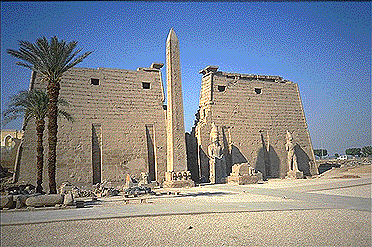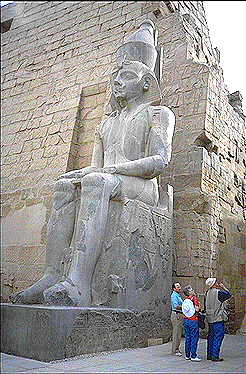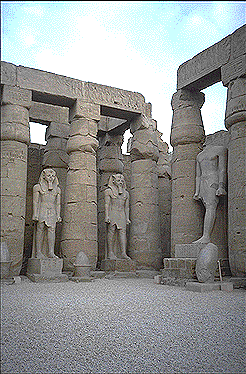Luxor - Luxor Temple

Pylon, Obelisk and Statues of Luxor Temple.
Like Karnak Temple, Luxor Temple is an accretion of structures erected by succeeding kings. The principal entrance today is the Pylon of Ramesses II (c.1279-1213 B.C.E.), which is flanked by two seated statues of the king (one is behind the obelisk) and one standing statue (of an original four). The remaining obelisk of pink granite is situated in front of the easternmost seated statue. The western obelisk has stood in the Place de la Concorde in Paris since 1836. The vertical niches held flag staffs.
The pylon entranceway is suggestive of the Egyptian hieroglyph which means "horizon." In the hieroglyph, the circle of the sun is flanked by two stylized mountain shapes. Most Egyptian temples had an east-west axis so that the sun would symbolically rise and set between these pylon/mountains. Luxor Temple, however, along with Dendera has a north-south axis.

Colossal Statue of Ramesses II Before Luxor Pylon.
Two colossal seated statues flank the entrance pylon of Luxor Temple. The easternmost (pictured here) is 46 feet/14meters in height. Ramesses II (c.1279-1213 B.C.E.) wears the royal nemes headdress topped by the Double Crown of Upper and Lower Egypt. The uraeus (rearing cobra--head now lost) surmounts his brow.

Statues of King Ramesses II in the First Courtyard of Luxor Temple.
Beyond the entrance pylon of Luxor Temple is the Court of Ramesses II. The colonnade of closed papyrus-bud columns, which originally lined the court on all four sides, today is interrupted in the northeast corner by the presence of the Mosque of Abu el-Haggag. Standing statues of Ramesses II fill most of the spaces between the columns. The crowns of several of these figures sit on the ground beside them because they were carved separately and have fallen off.
